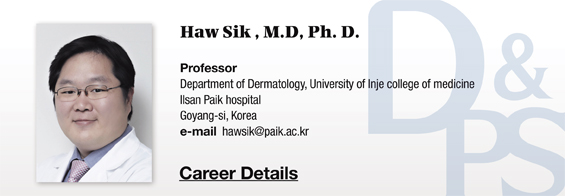▶ Previous Artlcle : #1-1. Vitiligo Treatment
2. Phototherapy
Ultraviolet is one of the oldest treatment modalities of vitiligo, dating back to the 1800s. The mechanism of action has not been clarified yet, but may be linked to facilitating the migration and proliferation of melanocytes, creating a favorable environment for melanocyte growth, and inhibiting autoimmunity.
[Advertisement] A-One LITE(Facial Diagnosys System) – Manufacturer: BOMTECH(www.bomtech.net)
Ultraviolet A (UVA) is a treatment option for vitiligo approved by the FDA, with slightly low efficacy as monotherapy. According to a study, high-dose UVA of 15 J/cm² induced 60% repigmentation in half of the patients. When combined with Psoralen, the efficacy was enhanced as much as to inducing 70-100% repigmentation of head and neck lesions in half of the patients.
Ultraviolet B (UVB), particularly 311 nm narrow band UVB, is the most favored method recently. Narrow band UVB is capable of inducing tyrosinase, an enzyme important for melanin synthesis, and increasing the expression of HMB45 on the surface of melanosome. The reported cure rate of narrow band UVB alone ranges from 41.6% to 100%. The efficacy is higher for lesions in children and newly forming lesions, especially those in head and neck, and is comparable or superior to that of PUVA. It is more effective for stabilizing the disease and inducing pigmentation, but takes a longer time to elicit a response, compared to PUVA.
Phototherapy devices require regular maintenance and repair for producing an adequate dose of irradiation. They should be examined periodically to confirm whether the dose is accurate, and proper adjustment of the dose should be made to protect patients from burns. Patients are vulnerable to burns especially when they resume the phototherapy after missing several weeks of treatment. 2011 issue of the JAAD recommended reducing the dose by 25% per week of every missed treatment.
Common side effects include erythema, pruritus and headache. Inappropriate dose adjustment may cause second degree burns. There is disagreement about whether phototherapy may cause skin cancer, but recent reports suggest that long-term UV therapy does not increase the risk of skin cancer.
Phototherapy and laser therapy are effective and safe enough to be used during pregnancy, but patients may get uncomfortable with having to undergo the treatment 2-3 times a week.

Excimer Laser
3. Laser Therapy
Although several lasers are used for the treatment of vitiligo, the most commonly used and effective one is the 308 nm excimer laser. The therapeutic mechanism seems identical to that of phototherapy, but laser therapy allows focused irradiation on lesions, thereby reducing overall dosage and influence on normal skin.
Laser therapy alone yields more than 75% repigmentation in more than half of patients. As with the previous treatment modalities, it is more effective for head and neck lesions and less effective for peripheral lesions. Unlike UV therapy, laser therapy is also effective in patients with dark skin and those not responding to UV therapy.
The efficacy is superior to the narrow band UVB phototherapy and can be enhanced by combining with topical agents, including hydrocortisone and tacrolimus.
Common side effects are self-limiting erythema and pruritus. Inappropriate dose adjustment or overlapping irradiation may cause burns.
‘Bioskin’, a 311 nm UBV device recently developed in Italy, is not a narrow band excimer laser, but is effective for vitiligo treatment by irradiating UVB focused on local lesion. Helium-neon laser with a wavelength of 632.8 nm is also used for the treatment of segmental vitiligo not responding to other therapies.
4. Surgery
Surgery is effective for stabilized lesions not responding to other therapies. When the lesion is not stabilized, the surgical site may not be repigmented well and vitiligo may develop even on where the grafts are harvested, due to the Koebner phenomenon.
Surgery can be roughly divided into grafting the tissue having abundant melanocytes or grafting melanocyte suspension. Suction blister grafting separates the epidermis from the dermis using negative pressure that causes blisters. After remove the roofs of the blisters, the epidermis is placed on an abraded vitiligo area.
The outcome is aesthetically excellent and the reported success rate is as high as 90%. However, there is still room for improvement, such as residual white rim after transplantation and color difference between the graft site and the surrounding tissues.
Split thickness skin graft is another option for vitiligo treatment. The biggest advantage of this method is that it can cover a broader site. Autologous melanocyte transplantation uses suspension, not tissues, produced by deepithelization of the tissues harvested from the donor site. Keratinocytes and melanocytes can be transferred together or melanocytes can be transplanted separately. This method is very effective, but it takes a lot of time and efforts to produce the suspension. Another advantage is that it is rarely limited by the surgical site.
5. Conclusion
Vitiligo is a refractory chronic disease, causing much stress and serious impairment of quality of life among patients, especially when the lesion is located in the exposed areas, such as face and the back of hands. When the condition is not treated properly for a long time, patients often give up treatment or turn to alternative measures. Therefore, close doctor-patient relationship is crucial for vitiligo treatment, and doctors need to encourage patients to pursue the right track when they have trouble complying with treatment.
Although not covered in this article, partial depigmentation should be considered for excessively extensive lesions, and camouflage cosmetics and makeup techniques are also worthwhile to be considered for lesions in the exposed area, not responding to treatments for a long time.
We have learned the cause and clinical features of vitiligo in this series. I hope this series was of any help for understanding and treating vitiligo in clinical practice. The next article will cover ‘laser toning’, which is one of the most promising procedures these days.
-To be continued-
▶ Next Artlcle : #2-1. The Etiology of Vitiligo: Autoimmune Theory and Neurohumoral Theory





















